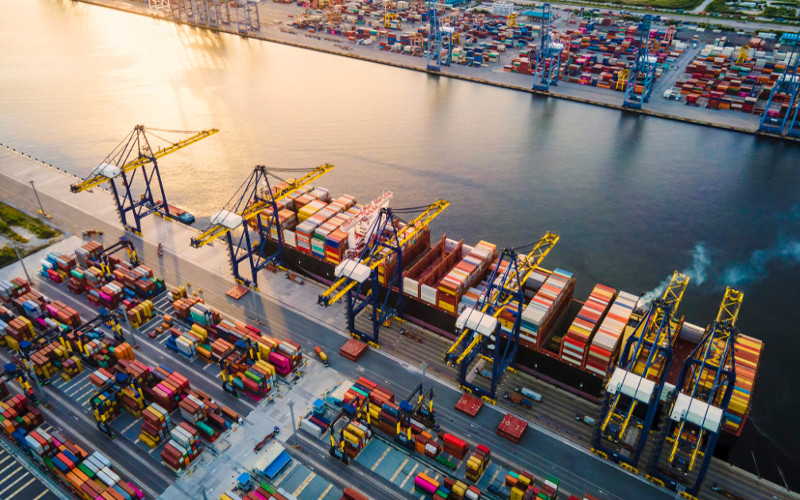Global supply chains face rising costs, labour shortages, and unpredictable disruptions, while customers expect faster, cheaper, and more transparent delivery. Logistics technology and automation are critical in navigating these pressures and building a future-proof supply chain. The logistics automation market reflects this, growing at a CAGR of 13.43%, from $88.09 billion in 2025 to $212.81 billion by 2032. This highlights the importance of strategic investment in logistics to improve efficiency, resilience, and competitiveness.
benefits of investing in logistics technology
Investing in logistics technology and automation delivers tangible benefits that directly impact competitiveness and efficiency, including:
- Improve planning and forecasting by using data-driven insights to predict demand and manage inventory effectively.
- Optimise warehouse operations by automating processes, reducing errors, and boosting throughput.
- Enhance production efficiency by synchronising logistics and manufacturing to eliminate delays.
- Strengthen decision-making by generating structured and reliable data across operations.
- Increase efficiency by streamlining processes and accelerating workflows.
- Reduce costs by lowering labour requirements and operational overheads.
Infosys BPM helps enterprise leaders unlock these benefits through tailored managed logistics services. By combining automation expertise with process transformation, these solutions enable organisations to build a resilient, future-proof supply chain that adapts to evolving business environments.
embracing logistics automation: key obstacles
While automation promises significant benefits, organisations often face practical barriers that slow adoption. The obstacles leaders must navigate to capture long-term value include:
- Resistance to change across teams: Cultural inertia and reluctance to adapt to new processes can derail automation efforts without strong change management.
- Integration with legacy systems: Outdated infrastructure often struggles to support modern logistics tools, creating implementation delays and higher costs.
- Lack of historical data for ROI calculation: Incomplete or inconsistent records make it harder to measure potential value and justify investment.
- Limited leadership vision: Without clear managerial direction, adoption loses momentum and fails to deliver measurable business outcomes.
strategies to justify investing in logistics technology
Securing leadership buy-in for logistics automation requires more than enthusiasm; it requires well-structured arguments, clear evidence, and industry best practices. Practical strategies to convince stakeholders and justify investment in logistics technology include:
demonstrating labour and cost savings
Automation reduces manual intervention, which leads to significant cost savings and efficiency gains. Highlight measurable reductions in overtime, errors, and workforce reliance to make a compelling case.
showcasing data-driven decisions
Advanced analytics provide actionable insights that allow managers to respond quickly to shifting market conditions. Showing how decisions based on accurate data outperform instinct-driven approaches builds trust.
leveraging cloud-based platforms
Cloud-based logistics solutions lower upfront infrastructure costs while offering scalability. Present cloud adoption as a flexible, future-ready model to justify the investment in logistics technology as both cost-effective and strategic.
timing investments with growth cycles
Rolling out automation when business demand is rising ensures maximum impact. Show how aligning technology with expansion phases accelerates ROI and supports sustainable growth.
presenting proven success stories
Case studies from industry peers demonstrate that logistics technology delivers measurable results. Using these examples provides credibility and reassurance to leadership teams assessing the business case for building a future-proof supply chain.
highlighting competitive pressures
Industry leaders are embracing automation to gain speed and efficiency. Pointing to industry benchmarks and market shifts underscores the risk of falling behind without a timely and strategic investment in logistics.
meeting stakeholder expectations
Investors, regulators, and customers increasingly expect transparency and efficiency. Positioning technology adoption as a way to meet these expectations strengthens stakeholder confidence and long-term business credibility.
backing claims with ROI analysis
Financial modelling provides tangible evidence of future value. Presenting ROI projections with realistic timelines makes decision-makers more confident in approving large-scale technology adoption.
addressing leadership scepticism
Executives may hesitate due to perceived disruption or high costs. A clear roadmap that outlines phased adoption and risk mitigation directly addresses such concerns.
providing actionable solutions
Positioning logistics technology as a tool to solve current business challenges adds practical weight to the proposal. Linking technology adoption to real-world issues ensures the argument resonates with leadership priorities.
best practices for building a future-proof supply chain
Adopting logistics technology and building a future-proof supply chain requires a structured approach. The following best practices help organisations reduce risks, capture value, and ensure lasting impact:
- Assess infrastructure to identify gaps and define automation priorities.
- Align technology with business strategy to ensure solutions support growth goals.
- Compare available solutions to choose platforms that fit operational requirements.
- Calculate expected ROI to create benchmarks for investment approval.
- Engage stakeholders early and keep them informed to encourage adoption.
- Develop an integration plan to minimise disruption during rollouts.
- Invest in employee training programmes to build skills for managing new systems.
- Apply robust data management practices to maintain accuracy and compliance.
- Monitor performance and promote continuous improvement to adapt processes as technologies evolve.
Smarter automation, AI-driven insights, and sustainability-focused innovation will define the future of logistics. Enterprises that invest in logistics solutions with advanced analytics, workforce support, and net-zero alignment will gain a strategic edge. These investments will position them to navigate the evolving market dynamics, regulations, and rising customer expectations with a future-ready supply chain.
conclusion
A strategic investment in logistics technology goes beyond process improvements. It builds resilience, lowers costs, and strengthens long-term competitiveness. By overcoming adoption challenges, justifying investments with clear ROI, and applying best practices, leaders can design a truly future-proof supply chain. As technology reshapes logistics, those prepared to embrace change will be the ones who define industry leadership.








